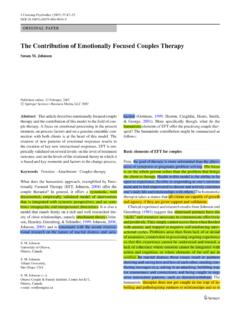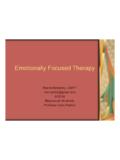Transcription of Distinguishing Emotionally Focused from Emotion-focused
1 Lorrie Brubacher, 2017_Distinguishing Emotionally Focused from Emotion-focused 1 Distinguishing Emotionally Focused therapy from Emotion-focused therapy Unpublished Manuscript The purpose of this article is to distinguish between Emotionally Focused therapy developed and researched by Dr. Sue Johnson (2004) and Emotion-focused therapy developed and researched by Dr. Les Greenberg (Elliott, Watson Greenberg & Goldman, 2004). The differences between Emotion-focused therapy and Emotionally Focused therapy are more than differences in spellings. Since the inception in the mid-eighties, the co-developers of the original model of Emotionally Focused couple therapy have expanded their models in different directions.
2 Currently Johnson is the director of the International Centre for Excellence in Emotionally Focused therapy with over ____ international members. She can be seen at: and Greenberg is the director of the Emotion-focused therapy Clinic in Toronto He can be seen at: and Johnson (Johnson, 2004) is the primary developer of the attachment-based model of Emotionally Focused therapy (EFT), integrating experiential and systemic interventions and approaches all within an attachment orientation. This model is used with couples , families and individuals, though currently most well known for its publications and empirical research with couples (Johnson, Hunsley, Greenberg and Schindler, 1999; Wiebe & Johnson, 2016).
3 This couple treatment model is also expanding as an empirically validated treatment for many disorders that have traditionally been viewed as individual problems. For example, Emotionally Focused therapy treatment within the attachment systemic context of couple therapy is effective with couples where partners suffer from posttraumatic stress disorder and from depression (Furrow, Johnson, & Bradley, 2011). Johnson integrated attachment theory as a salient part of the model and Greenberg shifted direction from the original couple therapy known as Emotionally Focused therapy (EFT)to a more intrapsychic individual therapy . When he did this, he altered the original name of Emotionally Focused therapy to Emotion-focused therapy or process-experiential therapy (Elliott, et al.)
4 , 2004; Greenberg, Rice & Elliott, 1993). This approach is most well-known for its intrasyschic humanistic-experiential work with and empirical research on individual psychotherapy, although more recently it is also used with couples and families. Greenberg s experiential-humanistic therapy (Elliott, et al, 2004; Goldman & Greenberg, 2015; Greenberg et al., 1993) focuses primarily on the dynamics of emotion, and this process-experiential approach, has received considerable empirical validation both for treating anxiety/trauma-related problems and for depression in individuals (Elliott, Greenberg, & Lietaer, 2004; Greenberg & Watson, 2006; Pavio & Pascual-Leone, 2010). A coaching form of Emotion-focused therapy or process-experiential therapy is also used with families.
5 A 5-stage, 14-step model (Greenberg & Goldman, Lorrie Brubacher, 2017_Distinguishing Emotionally Focused from Emotion-focused 2 2008) of Emotion-focused therapy for couples targets individual self-regulation before partner co-regulation. Attachment is presented as one of 3 motivational systems, and not as a definition of love. Shared Beginnings In spite of the divergent paths that Emotionally Focused therapy (Johnson, 2004, Johnson & Brubacher, 2016) and Emotion-focused therapy (Greenberg et al., 1993; Greenberg & Goldman, 2008) have taken, Emotionally Focused therapy (EFT) began in the mid 1980 s as one approach for working with couples . EFT was originally formulated, tested and empirically validated by Johnson and Greenberg in 1985 (Johnson & Greenberg, 1985a, 1985b, 1987, 1988) and the first manual for EFT couple therapy was published in 1988 (Greenberg & Johnson).
6 To develop the approach, Johnson and Greenberg began reviewing videos of couple therapy session to determine from bottom up observation, the elements that lead to change. They were influenced in their observations by the humanistic experiential approach of Carl Rogers and Fritz Perls, wherein emotion was seen for its power to create meaning and guide behavior. They also saw the need to add the systems perspective, from the systems theoretical view that the process of emotion, which includes meaning construction and behaviour, cannot be considered outside of the context in which it occurs. The original Emotionally Focused therapy is the first approach to have integrated humanistic-experiential theories (Rogers, 1951; Perls, 1969) with systems theory (Bertalanffy, 1969; Minuchin & Fishman, 1981).
7 In this experiential/systemic couple therapy approach, the problem is viewed as belonging not to one partner, but, rather, at the systemic level, to the cyclical reinforcing pattern of interaction between partners. Moreover, emotion is viewed not only as a within-individual phenomena that falls outside the bounds of systems theory, but also as a leading element that organizes the system s interactions (Arnold, 1960, Ekman, 2007; Frijda, 2007; Greenberg & Johnson, 1988; Johnson, 1998; Izard, 1997). Johnson discovered while viewing couple therapy videos, that the primary themes in couple distress were attachment themes of fear of loss and disconnection. Attachment theory became a foundational part of Johnson s expansion of the original 3-stage, 9-step EFT model, defining Emotionally Focused therapy s conceptualization of how distress arises in romantic relationships and of the process for how distressed relationships could be repaired (Johnson, 1986).
8 Similar Terminology Different Meanings Emotion-focused therapy (Greenberg) and Emotionally Focused therapy (Johnson) have different meanings. Emotion-focused therapy is frequently used synonymously used with process-experiential therapy (Elliott et al., 2004). In Greenberg s Emotion-focused approach the term Emotion-focused is used to refer to psychotherapy approaches in general that pay heed to emotion. Greenberg (2002a) decided that on the basis of the development in emotion theory that treatments such as the process experiential approach, as well as some other approaches that emphasized emotion as the target of change, were sufficiently similar to each other and different from existing approaches to merit being grouped under the general title of Emotion-focused approaches ( , Greenberg & Goldman, 2008).
9 Greenberg uses the term emotion-Lorrie Brubacher, 2017_Distinguishing Emotionally Focused from Emotion-focused 3 Focused to suggest a broad integration or umbrella term, embracing many different therapies suggesting an emotion focus could be a common factor, and to move away from different name-brands of therapy (2010). Greenberg and Goldman, 2015, noted their choice to use the phrasing of Emotion-focused to refer to therapeutic approaches that Focused on emotion (p. x, 2008). "The term Emotion-focused therapy will, I believe, be used in the future, in its integrative sense, to characterize all therapies that are Emotion-focused , be they psychodynamic, cognitive-behavioral, systemic, or humanistic" (Greenberg, 2011b).
10 In contrast, Johnson s (2004) Emotionally Focused therapy is a reference to a specific model of relationship therapy , not to be confused with other approaches that may include a focus on emotion. Emotionally Focused therapy explicitly integrates systems and experiential approaches and places prominence upon attachment theory as a theory of emotion regulation (Coan & Maresh, 2014). Emotionally Focused therapy views attachment needs as a primary motivational system for mammalian survival. Emotionally Focused therapy has expanded to be centered upon attachment theory as a theory of adult love wherein attachment, caregiving, and sex are intertwined (Cassidy & Shaver, 2016; Shaver & Mikulincer, 2006).










